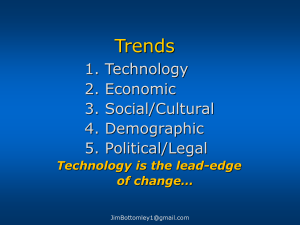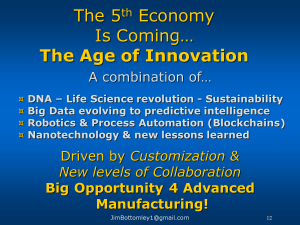 Let’s jump into the future. What will drive change in 2019? What megatrends explain the unusual and sometimes scary times we live in?
Let’s jump into the future. What will drive change in 2019? What megatrends explain the unusual and sometimes scary times we live in?
I’m an entrepreneur and working futurist who performs trend analysis across sectors, helping clients find opportunity and develop strategies for future success. As a professional speaker I make predictions and contend that for 2019, change is accelerating. And it changes that causes stress. The key to reducing the stress of change is to decide how to react to it. New strategies are required for our times.
What is the value of a futurist? To make weather forecasters look good.
Over the years I’ve learned the hard way that it is a fool’s game to predict actual numbers, such as interest rates, for a specific future time. The world is too complex and variable to perform accurate numerical predictions. My method is different. I base my work on the premise that all success comes from meeting human needs in better ways. I analyse how trends interplay to impact needs, looking for improved need satisfaction strategies.
When I facilitate strategic planning sessions, we examine the following trend categories. Change converges in this order to affect our future:

I list the trends in this order because that is how change moves through society. Technical change directly affects the economy and the nature of jobs—more than any other time, we are in an era of career disruption. The values that guide us shift (social/cultural trends), which ultimately morphs demographics and produces generational change. Politicians and the legal community are the last to address the changes initiated by technology. In 2019, more will be coming to regulate big social media (given election hacking and privacy issues) and lobbying efforts will increase as the purveyors of fundamental new technologies try to guide future legislation.
Because information is shared more quickly, and innovation which requires collaboration is enhanced with new technologies, technical change will launch at a faster pace. From Artificial Intelligence to the Blockchain, from Biotech to Nanotechnology, a blizzard of technical change is coming. Strap in, because we ain’t seen nothing yet.
Here are the big 3 megatrends converging to impact 2019.
1) TECHNICAL CHANGE ACCELERATES AS WE ENTER THE INNOVATION AGE
We have entered a new economy. Can you feel it? The disruption?
Because information is shared more quickly, and innovation which requires collaboration is enhanced with new technologies, technical change will launch at a faster pace. From Artificial Intelligence to the Blockchain, from Biotech to Nanotechnology, a blizzard of technical change is coming. Strap in, because…we ain’t seen nothing yet.
The biggest social trend underlying this transformation is the impact of the changing nature of jobs, work, and careers. Manufacturing will increasingly become more productive as robotics displace human labour. If we look at the percentage of workers employed making a product you can touch, see and feel, we’ve gone from a peak of over two-thirds of us working in those environments, declining towards ten percent today.

THE BIGGEST SOCIAL CHALLENGE WORLDWIDE: What career will a high-school dropout (or graduate) obtain in future, when, in the past, they could score a decent-paying factory job? In every profession, technology intrudes, and the education bar has gone up for every career. We are transforming to a society of cultural haves and have-nots, based on education levels achieved. This is a destabilizing trend worldwide and feeds the populist movements.
Yet, the positives of new technology are clear. We produce vastly more food with less than 2% of us working in that sector than we did in pioneer days when the vast majority farmed.
The challenge today is similar to the era when the economy transformed from steam to electric. If you were a factory owner with a steam-powered process, you wouldn’t take the risk of investing fully in a complete transformation; you’d buy one electric machine and try to knit it into your existing steam operation. It didn’t go well. It’s the same with our current transformation from analog to digital. We try to support old legacy systems, layering on the latest digital technologies. As yet, the promise of these new technologies has not been fully fulfilled. Productivity growth remains anemic. Without productivity gains, wages don’t rise.
Until we better sort out the transition, the risk is more economic pain for the workers in society. The good news is that these technologies are real, their impact will be great. Productivity will start to take off. I believe we will eventually achieve long-term gains, but the timing and degree of impact depend to a great deal on what strategies we choose to deploy. For example, a guaranteed income will be offered in test cases worldwide.
China’s economic success is challenged by this first megatrend: We are entering an era where cheap labour is less important to manufacturing success, and this was the core better benefit in the first place that propelled China to be the world’s manufacturing hub.
The tide of technology will not stop. To harness the good from technologies, the secret is to examine a technology’s impact on improving human needs. If that technology improves need satisfaction, if it aids your organization in delivering a better benefit to the customers you serve, then it needs to be incorporated into your operation. Uncovering better benefits and making them goals for the future is the core of my unique planning process. Moving forward, there will be more technologies in 2019 than ever before to evaluate in this way.
2) THE ARGUMENT OF OUR TIMES: GLOBALISM VS POPULISM
Over the economic eras, the nature of who we fought changed over time. In Hunter/Gatherer times we fought the other tribes. In the Agricultural Age, as people settled communally, we fought the other city-states. In the Industrial Age, we carved borders through tribes and colonized, creating nations. Of course, the nations ended up fighting, two World Wars last century. So, we’ve gone from fighting the tribe, to fighting the city, to fighting the nation. What’s next?
My hope is that humans are evolving, that in future we won’t need to fight. For this to happen, over the next fifty years the world’s values must transform.
The cornerstone of this future is to recognize that we live in one world, are one people, that different skin colours, religions and cultures should not only be tolerated but respected. For peace to reign, humans will have to work out common rules for human rights, the environment, and trade.
The problem is that for every social trend, there is pushback by a minority who fears change. This is happening to the promise of globalization worldwide.
What drives the Trump phenomenon? What powers the growing populist movements worldwide? Resistance to globalization.
Educated people in many professions travel across borders to work. They don’t perceive nation states as all that important. For locals who’ve seen factory jobs lost, who rely on the local economy for job growth, globalization is often perceived as a horror. Jobs displaced. People fearful of change.
All the policies President Trump espouses are the cornerstones of resistance to globalization. Interestingly enough, you can take any position on this chart and argue the validity of that point of view. Enforced political correctness often encourages resistance to social change.
Of note, the worst depression in history was caused primarily by trade wars initiated by the USA. Will history repeat? Can a deal be made with China? How will trade rules evolve this coming year? Failure here is the world’s biggest economic risk.
Globalists need to better prepare their arguments espousing the value of their vision. For example, as globalization rolled out, extreme poverty worldwide dropped from 36% to 9%, making millions of lives better.
Underlining it all, in fact, the key to winning the argument for globalization, is encouraging empowerment of women worldwide. If I could only pick one strategy to make the world better, this is it.
3) ALL JOBS, ALL INDUSTRIES, ARE TRANSFORMING
In light of these two megatrends, all workplaces are transforming.
Boundaries of all professions are changing.
The YMCA™ doesn’t just serve people from their traditional brick-and-mortar locations, they now bring their programs to the schools. Retail can’t compete against online offerings unless they offer an enhanced shopping experience. The Insurance Industry is transitioning from insuring tangible assets to intangibles, such as cybercrime. Car manufacturers won’t be selling cars, they’ll be providing mobility services. In the future, is a pipeline a conveyor of oil, or is it a community builder? Technologies and changing customer expectations mean that boundaries are in question for all professions and whole industries are being redefined.
Customization is the ultimate better benefit (and more possible to achieve)
Customers are more demanding. They can scout online and evaluate options more readily than ever before. They increasingly demand customized services. Greater customization means more interaction. Dr. Scholl’s™ uses new technologies to allow better customization of shoe-fit in-store. A new smart-wine has RFID sensors on it, evaluating temperature through shipment to ensure quality; but these winemakers have yet to realize they could embed whimsical stories about their winery, scanned by smartphones to improve dinner party value. For agriculture, ultimate precision farming to improve yields will mean that, in future, every seed planted will be a different depth. Additive manufacturing processes utilizing 3D printing allow each object produced to be customized. Since customization is the ultimate better benefit for customers, it supports higher prices and better margins. Although demanded by constituents, the challenge of providing customization will be an increasing challenge for governments worldwide. Government workers who have traditionally served all citizens in an equal fashion will be greatly stressed by the demands for exceptions, tweaks, and customization.
New forms of collaboration will define the future
Should we each go it alone, evaluating technologies in a vacuum? Whether it is trying to get steam to work with electric, analog with digital, incorporating blockchains or researching Nano solutions, I believe a collaborative approach produces better solutions. Collaboration allows for sharing the risks of transformation. I recommend Industry Associations form research groups within their membership, where some will band together to work out solutions that they could then share with others. Local economies will increasingly benefit by creating Innovation Networks.to create local jobs. Industry Clusters will be struck to work out new methodologies and figure out how to incorporate them into workplaces. The ultimate collaboration is with customers, looping back to better understand their changing needs. The result is being able to identify and provide relevant better benefits for customers into the future, the key to strategic success.
Yes, change and disruption are in the air. These three Megatrends will rock 2019. Their impact will cause greater worldwide stress and likely will cause a short-term economic pullback. I have optimism for the future, but it depends on what we do.
I hope I have provided you greater insight into what is driving change and, more importantly, I hope some of the strategic tips from this blog will enable you to create a better future for your organization, and yourself, in 2019.
Future smiles!
Jim Bottomley is an entrepreneur and consultant who has spoken to audiences totaling 270,000 about future success strategies to better navigate change.